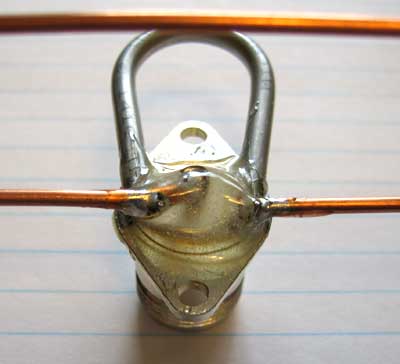Building UHF Antennas
Published in QST
magazine (August 2006).
This method of construction can be used on most UHF through "low" microwave
Yagis, and is especially useful for the 33, 23 and 13 cm bands;
These antennas were made
with this process, and tested on this
back-yard antenna range.
I like to use the basic DL6WU wideband Yagi designs whenever possible. A good
design tool for this is the Yagi calculator written by
VK5DJ.
Here's how to make one using basic hand tools and readily available materials.
Parasitic Elements
Shown here are all of the parasitic elements prepared for the four 48" 23 cm
Yagis I used on a 23 cm beacon array. It does help to organize the elements
like this prior to attachment to the boom.
For material, I usually use 1/8" aluminum welding filler rod. it is
inexpensive, easily cut to size with wire or bolt cutters, and holds up well
in weather. Once cut to size, trim the ends flat with a file.
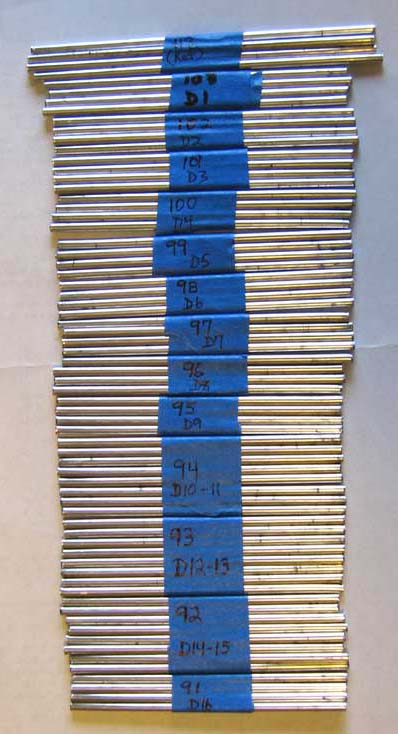
These antennas were designed for full metal-to-metal contact between the
boom and the parasitic elements, so be certain to keep that in mind when
designing an antenna with whichever calculator you use.
A simple method for attaching the elements to the boom is described later
in the process.
Mark the Boom Ends
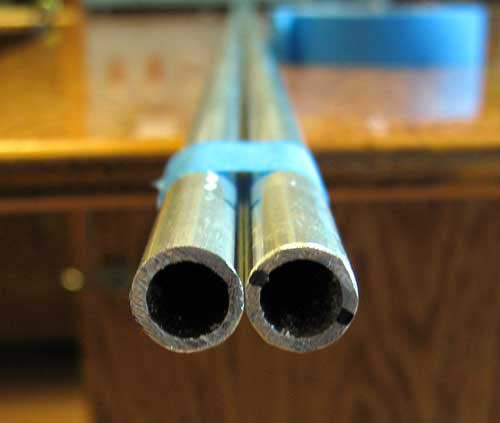
Prepare the boom by cutting it to the proper length. Then,
-
Using a laundry marker, mark
the end of the boom on opposite sides as shown (the one on the right is the
one we are working on).
-
Tape the boom securely to a
marking guide, positioning one of the end marks so that it almost touches
the guide.
I used another piece of tubing as a guide,
but one can use almost anything that is straight, even a piece of wood.
In the next step, you will be
drawing a straight line down the length of the boom.
Mark the Boom
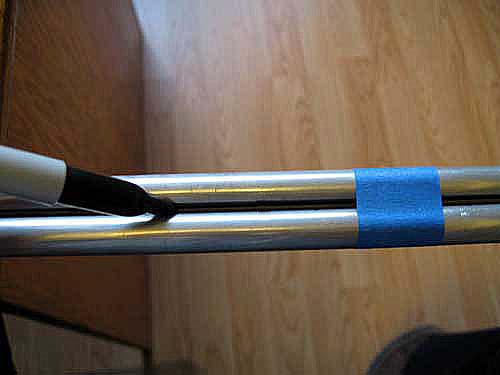
Place the tip of your marker in the joint between the
boom and the guide, and mark a line down the entire length of the boom.
You will probably need to tape the boom to the guide in
several places to prevent the marker from forcing the boom away from the guide.
Un-tape the boom from the guide, and rotate the boom to the
opposite side using the other locating mark you made at the end of the boom as a reference. Re-tape the boom to the guide and mark a line down this side
also.
Now that you have both lines drawn, place tick marks on the
lines (both sides of the boom) where the holes for the parasitic elements must be drilled,
as shown in the picture below.
Measure from the end of the boom to each mark to eliminate cumulative errors.
Finally, use a center punch to prep the locations (both sides)
that will be drilled for the parasitic elements. If you will use 1/8" diameter
elements, use a 1/8" drill bit.
Drill the holes one side at a time...a common mistake is to
drill all the way through the boom in one pass. This will always result in
crooked elements unless you are using a drill press, and even then it's
difficult to do properly that way.

Attach the Elements
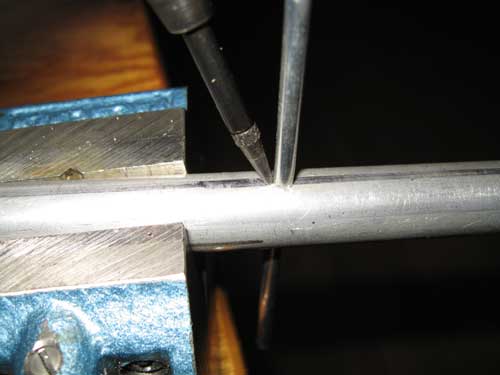
Secure the parasitic elements to the boom:
-
Hold the boom in a small vise
as shown.
-
Insert and center an element
into the boom, beginning with the reflector. Use a small hammer and tap it
through gently.
-
Using a center punch, stake the
boom next to the element in two places, preferably opposite one another.
Stake at a 45 degree angle toward the element as shown on the right, and at the 10:30 and 4:30
positions as shown in the inset below.

Align the Elements
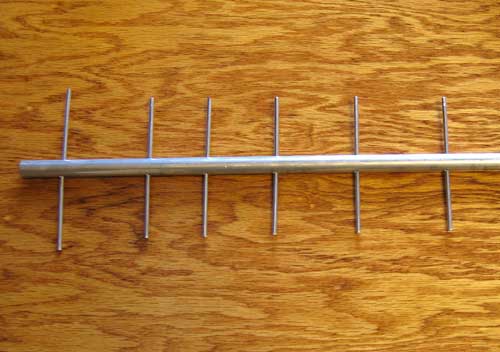 If
you did a good job with your humble hand tools, your antenna should look
something like this.
If
you did a good job with your humble hand tools, your antenna should look
something like this.
You may find an element or two out of alignment with the
others as you sight down the boom... it never goes perfectly, especially for me.
If you need to adjust an element, grasp the end and bend it
slightly to put it in alignment with the others.
If you look closely, you can see a slight 'zig' in the
alignment of the reflector on this antenna. I bent this into position after
discovering it was just out of alignment with the first director.
These small adjustments will not affect the performance of the
antenna.
Driven Element Parts
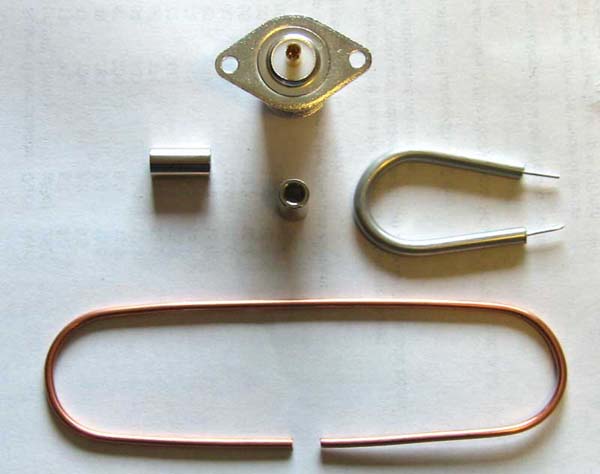
For
the driven element, you will need:
-
One chassis-mount
style N connector (at least 2 opposing mounting holes are needed), with Teflon insulation
(not plastic).
-
Two 1/2" to 3/4"
aluminum or brass spacers
-
#12 copper wire
for the folded dipole
-
A piece of .141
semi-rigid coax for the 1/2 wave balun.
The smooth part of a screwdriver handle makes a good form
for bending both the balun and the dipole element.
Driven Element Closeup
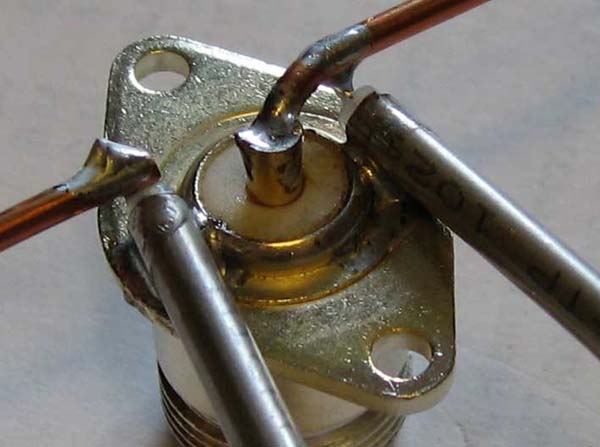
I
usually wrap the barrel and threads of the N connector with several layers of
paper, and hold it in a small vise. The paper protects the threads and slows heat
loss to the vise while soldering.
Solder the shield of the .141 coax balun to the connector as
shown.
Next, trim the solder cup of the N connector a bit, and solder
one end of the dipole into it. Making a small bend into the cup of the pin is
helpful.
Last, bend the center conductors of the balun under and around
the ends of the dipole and solder as shown. Be careful to leave a small gap
between the outer conductor of the balun and the ends of the dipole (about 2
mm).
Almost Done - DE
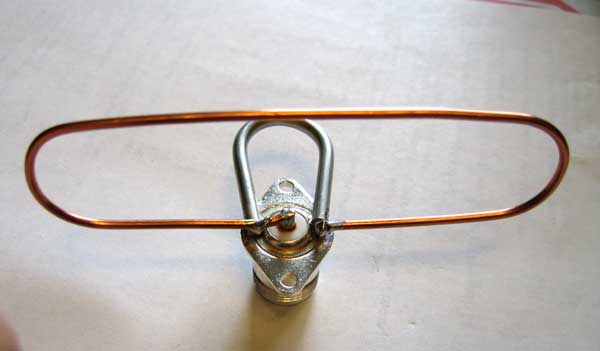
OK,
to the right is what it should look like now.
Apply a generous coat of epoxy to the connections for
strength and weatherproofing (see the left picture at the bottom).
Not all epoxies are created equal, be certain to test a cured
lump in a microwave oven before using it on the antenna. Place your epoxy sample
next to a cup of water in the microwave, and cook for 1 minute. If the epoxy is
hot, try another brand. Just warm is OK.
The second picture below shows a final coat of white latex paint
covering the epoxy seal and the copper dipole.
Finishing Up
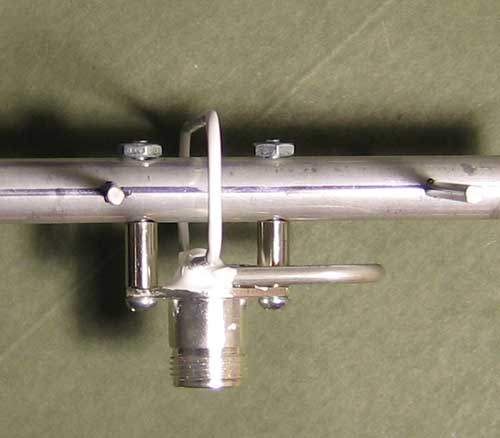
All
that is left to do now is mount the driven element to the boom. For this I used
1/2" aluminum spacers and 6-32 machine screws.
Make certain you have the dipole placed at the correct
distances from the reflector and first director before drilling the mounting
holes in the boom.
The picture below shows the completed 4' antenna, held by my
trusty XYL (she's still shaking her head).
You may not need to tweak at all, but if you do, SWR is
affected by the shape of the dipole (height). You can also bend the ends toward
or away from the reflector as an additional adjustment. You should be able to
get the antenna down below 1.2/1 at mid-band, and below 1.5/1 at the band edges.
If you plan on stacking Yagis, and need to flip one of the
antennas over, you can put that antenna back in phase without having to make a
'mirror' dipole. Notice that I have the DE mounted so that the balun loop is
toward the reflector? Just mount the DE so the balun loop points the other way.
This will put it back in phase with the antenna on the top. You can see this
done here.







 If
you did a good job with your humble hand tools, your antenna should look
something like this.
If
you did a good job with your humble hand tools, your antenna should look
something like this.


